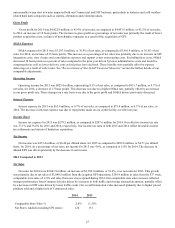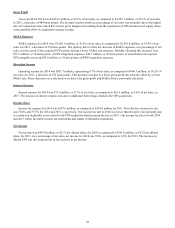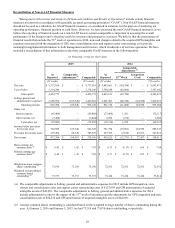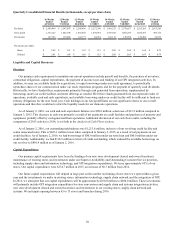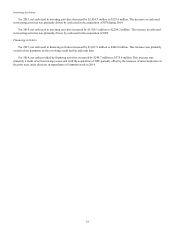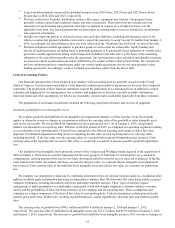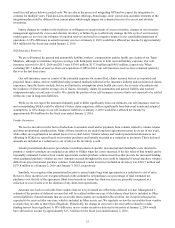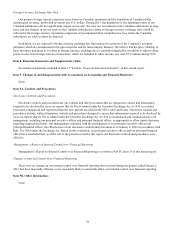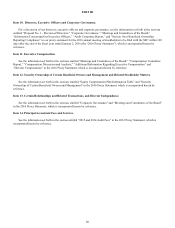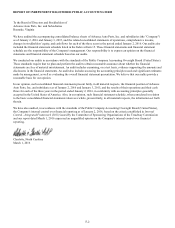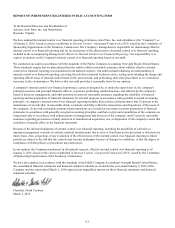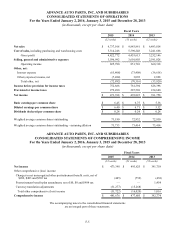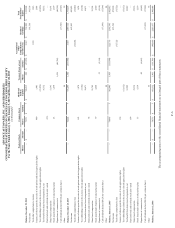Advance Auto Parts 2015 Annual Report Download - page 50
Download and view the complete annual report
Please find page 50 of the 2015 Advance Auto Parts annual report below. You can navigate through the pages in the report by either clicking on the pages listed below, or by using the keyword search tool below to find specific information within the annual report.37
result in retail prices below recorded costs. We are also in the process of integrating GPI and we expect the integration to
continue for multiple years. Final decisions about product offerings, brand usage, store conversions and other elements of the
integration plan could be different from current plans which might impact our estimated reserves for excess and obsolete
inventories.
Future changes by vendors in their policies or willingness to accept returns of excess inventory, changes in our inventory
management approach for excess and obsolete inventory or failure by us to effectively manage the life cycle of our inventory
could require us to revise our estimates of required reserves and result in a negative impact on our consolidated statement of
operations. A 10% difference in actual inventory reserves at January 2, 2016 would have affected net income by approximately
$4.4 million for the fiscal year ended January 2, 2016.
Self-Insurance Reserves
We are self-insured for general and automobile liability, workers’ compensation and the health care claims of our Team
Members, although we maintain stop-loss coverage with third-party insurers to limit our total liability exposure. Our self-
insurance reserves for 2015, 2014 and 2013 were $134.0 million, $137.0 million and $98.5 million, respectively. When
excluding $41.7 million of reserves from our acquisition of GPI in 2014, our self-insurance reserves have remained relatively
flat over the last three years.
Our self-insurance reserves consist of the estimated exposure for claims filed, claims incurred but not yet reported and
projected future claims, and are established using actuarial methods followed in the insurance industry and our historical claims
experience. Specific factors include, but are not limited to, assumptions about health care costs, the severity of accidents and
the incidence of illness and the average size of claims. Generally, claims for automobile and general liability and workers’
compensation take several years to settle. We classify the portion of our self-insurance reserves that is not expected to be settled
within one year in long-term liabilities.
While we do not expect the amounts ultimately paid to differ significantly from our estimates, our self-insurance reserves
and corresponding SG&A could be affected if future claim experience differs significantly from historical trends and actuarial
assumptions. A 10% change in our self-insurance liabilities at January 2, 2016 would have affected net income by
approximately $8.4 million for the fiscal year ended January 2, 2016.
Vendor Incentives
We receive incentives in the form of reductions to amounts owed and/or payments from vendors related to volume rebates
and other promotional considerations. Many of these incentives are under long-term agreements (terms in excess of one year),
while others are negotiated on an annual basis or less (short-term). Volume rebates and vendor promotional allowances not
offsetting in SG&A are earned based on inventory purchases and initially recorded as a reduction to inventory. These deferred
amounts are included as a reduction to cost of sales as the inventory is sold.
Vendor promotional allowances provided as a reimbursement of specific, incremental and identifiable costs incurred to
promote a vendor’s products are included as an offset to SG&A when the cost is incurred, if the fair value of that benefit can be
reasonably estimated. Certain of our vendor agreements contain purchase volume incentives that provide for increased funding
when graduated purchase volumes are met. Amounts accrued throughout the year could be impacted if actual purchase volumes
differ from projected annual purchase volumes. Total deferred vendor incentives included in inventory was $210.7 million and
$179.8 million as of January 2, 2016 and January 3, 2015, respectively.
Similarly, we recognize other promotional incentives earned under long-term agreements as a reduction to cost of sales.
However, these incentives are recognized based on the cumulative net purchases as a percentage of total estimated net
purchases over the life of the agreement. Short-term incentives (terms less than one year) are generally recognized as a
reduction to cost of sales over the duration of any short-term agreements.
Amounts received or receivable from vendors that are not yet earned are reflected as deferred revenue. Management’s
estimate of the portion of deferred revenue that will be realized within one year of the balance sheet date is included in Other
current liabilities. Earned amounts that are receivable from vendors are included in Receivables, net except for that portion
expected to be received after one year, which is included in Other assets, net. We regularly review the receivables from vendors
to ensure they are able to meet their obligations. Historically, the change in our reserve for receivables related to vendor
funding has not been significant. A 10% difference in our vendor incentives deferred in inventory at January 2, 2016 would
have affected net income by approximately $13.3 million for the fiscal year ended January 2, 2016.


